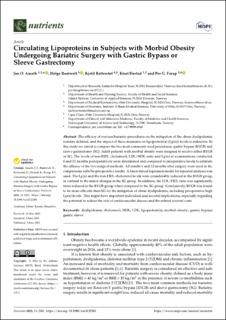| dc.contributor.author | Aaseth, Jan | |
| dc.contributor.author | Rootwelt, Helge | |
| dc.contributor.author | Retterstøl, Kjetil | |
| dc.contributor.author | Hestad, Knut | |
| dc.contributor.author | Farup, Per Grønaas | |
| dc.coverage.spatial | Norway | en_US |
| dc.date.accessioned | 2023-01-27T09:47:00Z | |
| dc.date.available | 2023-01-27T09:47:00Z | |
| dc.date.created | 2022-09-12T09:37:10Z | |
| dc.date.issued | 2022 | |
| dc.identifier.citation | Nutrients. 2022, 14 (12), . | en_US |
| dc.identifier.issn | 2072-6643 | |
| dc.identifier.uri | https://hdl.handle.net/11250/3046791 | |
| dc.description.abstract | The efficacy of various bariatric procedures on the mitigation of the obese dyslipidemia remains debated, and the impact of these measures on lipoprotein(a) (Lp(a)) levels is unknown. In this study we aimed to compare the two most commonly used procedures: gastric bypass (RYGB) and sleeve gastrectomy (SG). Adult patients with morbid obesity were assigned to receive either RYGB or SG. The levels of non-HDL cholesterol, LDL/HDL-ratio and Lp(a) at examinations conducted 6 and 12 months postoperatively were determined and compared to preoperative levels to estimate the efficacy of the two surgical methods. All results 6 and 12 months after surgery were used in the comparisons with the preoperative results. A linear mixed regression model for repeated analyses was used. The Lp(a) and the non-HDL cholesterol levels were considerably reduced in the RYGB group, in contrast to the minor changes in the SG group. In addition, the LDL/HDL ratio was significantly more reduced in the RYGB group when compared to the SG group. Conclusively, RYGB was found to be more efficient than SG for the mitigation of obese dyslipidemia, including preoperative high Lp(a)-levels. This might have important individual and societal implications, especially regarding the potential to reduce the risk of cardiovascular disease and the related societal costs. | en_US |
| dc.description.sponsorship | The work was funded from Innlandet Hospital Trust, Brumunddal, Norway | en_US |
| dc.language.iso | eng | en_US |
| dc.rights | Navngivelse-Ikkekommersiell-DelPåSammeVilkår 4.0 Internasjonal | * |
| dc.rights.uri | http://creativecommons.org/licenses/by-nc-sa/4.0/deed.no | * |
| dc.subject | HDL | en_US |
| dc.subject | LDL | en_US |
| dc.subject | cholesterol | en_US |
| dc.subject | dyslipidemia | en_US |
| dc.subject | gastric bypass | en_US |
| dc.subject | gastric sleeve | en_US |
| dc.subject | lipoprotein(a) | en_US |
| dc.subject | morbid obesity | en_US |
| dc.title | Circulating Lipoproteins in Subjects with Morbid Obesity Undergoing Bariatric Surgery with Gastric Bypass or Sleeve Gastrectomy | en_US |
| dc.title.alternative | Circulating Lipoproteins in Subjects with Morbid Obesity Undergoing Bariatric Surgery with Gastric Bypass or Sleeve Gastrectomy | en_US |
| dc.type | Peer reviewed | en_US |
| dc.type | Journal article | en_US |
| dc.description.version | publishedVersion | en_US |
| dc.rights.holder | © 2022 by the authors. Licensee MDPI, Basel, Switzerland. This article is an open access article distributed under the terms and conditions of the Creative Commons Attribution (CC BY) license (https:// creativecommons.org/licenses/by/ 4.0/). | en_US |
| dc.subject.nsi | overvekt | en_US |
| dc.subject.nsi | vektreduksjon | en_US |
| dc.subject.nsi | gastroenterologi | en_US |
| dc.subject.nsi | sykelig overvekt | en_US |
| dc.subject.nsi | comorbiditet | en_US |
| dc.subject.nsi | magetarm funksjonen | en_US |
| dc.subject.nsi | kirurgisk operasjon | en_US |
| dc.subject.nsi | bio-psyko-sosiale faktorer | en_US |
| dc.source.pagenumber | 8 | en_US |
| dc.source.volume | 14 | en_US |
| dc.source.journal | Nutrients | en_US |
| dc.source.issue | 12 | en_US |
| dc.identifier.doi | 10.3390/nu14122381 | |
| dc.identifier.cristin | 2050601 | |
| dc.source.articlenumber | 2381 | en_US |
| cristin.ispublished | true | |
| cristin.fulltext | original | |
| cristin.qualitycode | 1 | |

